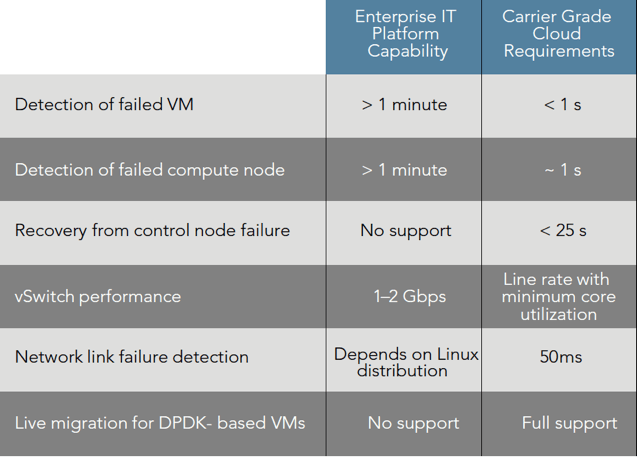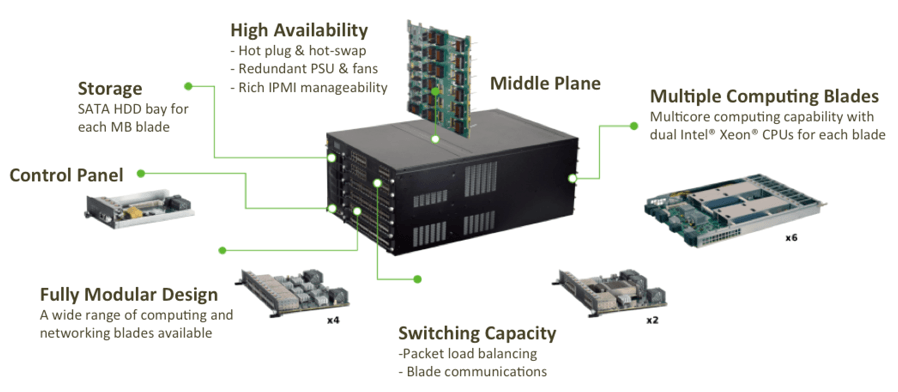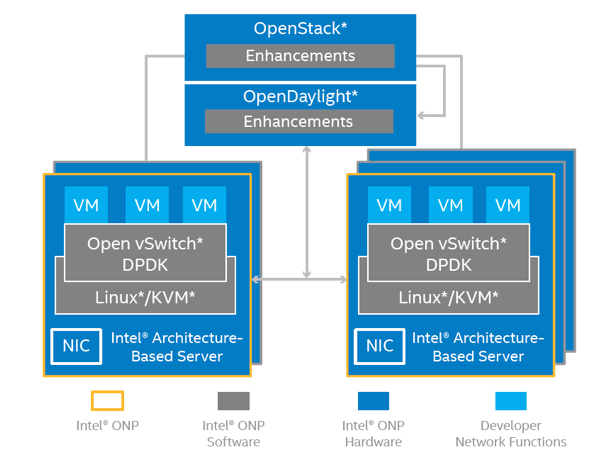Achieve Carrier-Grade Uptime With NFV
Already well established in the datacenter, network functions virtualization (NFV) is finally making its way into the telecom network. But there is a major hurdle ahead. Carrier-grade NFV must combine telecom and datacenter functionality in a single box at the edge – with carrier-grade uptime.
For equipment vendors used to datacenter NFV, this means a major leap in capabilities (Figure 1). For one thing, availability requirements jump from three-nines (99.9%) to a minimum of five-nines (99.999%).

Meeting these elevated requirements requires a rethink of the underlying hardware. Equipment suppliers should consider standards-based datacenter equipment only a starting point. To meet the operators' needs, they will need to augment their designs with additional hardware and software features and functionality.
The March To NFV
A key driver toward NFV is that it decouples functions from hardware. "Carriers no longer need to go to a single vendor for a hardware/software package," says Sven Freudenfeld, Global Business Development Director for Telecom Appliances at Lanner Electronics Inc. Instead, carriers are looking for general-purpose hardware that can run any software. "It's a different model altogether," he explains.
This new model liberates service providers and helps drive down costs for the underlying hardware. But hardware requirements are changing as operators combine central office (CO) (telecom) and datacenter services at the edge for mobile networks.
Mobile edge computing hardware and software still needs to support the installed telecom infrastructure for mission-critical functions such as E911 calls, which brings about the need for 99.999% uptime. This translates to a network downtime of only 25.9 seconds per month, versus 43.8 minutes per month for datacenters.
To accommodate requirements like these, carriers and service providers are taking a hybrid approach. They are looking for equipment with carrier-grade performance but the flexibility and scalability of datacenter hardware.
5G Pushing Network Performance
Per Freudenfeld, 5G is the key driver for carrier NFV—and the need to combine telecom and datacenter features. Even before it has been defined, 5G is already pushing the limits of network flexibility and scalability. It not only implies more data at the edge but also more diversified data types with very different applications, from streaming high-definition video, to automotive, to IoT.
"They all have dedicated needs, and you have many more devices connected, so you need more bandwidth," notes Freudenfeld. Some applications are not critical, such as streaming video, but others are. "If I am monitoring a patient's heartbeat and I lose my network for 10 minutes, the patient could be dead: That's why you need a high-availability feature set in the network."
Getting to carrier-grade, securely and cost-effectively
Carrier-grade equipment refers in large part to ETSI requirements. These include 50-ms failovers for IP packets, the ability to self-reboot, the use of hot-swappable and redundant power supplies, as well as NEBS compliance for the chassis itself.
NEBS is an industry-standard set of safety, spatial, and environment design guidelines for telecom equipment. Currently managed by Telcordia, it covers requirements such as vibration, failover, airflow patterns, acoustic limits, RF emissions, ESD, and surface finishes.
Manageability is also critical. "You need full visibility into the platform as edge computing is often at remote sites," comments Freudenfeld, "so you need to be aware of minor or critical alarms, event locks, or if you have to reset a board."
Freudenfeld pointed to Lanner's HTCA-6200 platform, which it built specifically for carrier certification (Figure 2). This meant pulling elements from the ATCA standard such as a 100 GbE-capable backend, while removing ATCA's 350-W/blade power limitation. "We're a little over that budget, but the chassis is built by Lanner, versus a third party, so we can manage that," explains Freudenfeld.

This ability to control and optimize is one main reason for moving away from the ATCA specification. In Lanner's case, this led to development of its ATCA-based HybridTCA (HTCA) platform.
HTCSA uses a dense, modular design that integrates the control plane and data plane in a single appliance, with a throughput of up to 400 or 640 Gbits/s. The modular approach allows Lanner to scale its solutions from 1U to 2U today, with headroom for 6U designs in the future.
The resulting systems offer abundant, flexible performance. For example, HTCA-6200 runs on four Intel Xeon processor E5-2690 CPUs, supported by the Intel C612 chipset, dual I/O blades, and 16 DDR4 R-DIMM sockets.
The systems are also built for telecom use. As an example, Freudenfeld pointed to HTCA-6200's dual AC 1200-W N+1 supplies with PMBus support for digital power control.
Open Networking Platform
As an example of the level of density and reduced footprint, Freudenfeld pointed out that Lanner took Intel®'s Open Networking Platform (ONP), which normally is spread across a separate server and a switch, and collapsed it into one system. "So we're combining switching, compute, and management into the same platform," he says.
Intel® ONP is a server reference architecture that brings together key hardware and open software for NFV and SDN (Figure 3). It is based on a standard-high-volume server and an Intel ONP open-source software stack. Key ingredients include OpenStack Liberty, OpenDaylight Beryllium, and Open vSwitch 2.5.

For its Linux build, Lanner went with Wind River Titanium Server. This carrier-grade platform offers carrier-grade reliability, performance, and security. On top of Titanium Server, Lanner is running Trend Micro's Virtual Network Function Suite.
Trend Micro's DPI suite checks network packets and performs select functions such as intrusion prevention, application controls, or URL filtering, all in a single scan.
Moving Forward
While NFV has the attraction of lowering costs and enabling enhanced data services, doing it at carrier grade across telecom and datacenter networks requires greater attention to system reliability and longevity.
Lanner Electronics has addressed this in its HTCA-6200 appliance through a low-latency, highly secure, highly reliable system and network design, while also paying attention to footprint, interoperability, and scalability.
Not many network equipment suppliers are equipped to deliver on all these requirements, so network architects need to dig deep to uncover those that are capable.